Sorry, this entry is only available in European Spanish.
Tag Archives: energía solar térmica en latinoamérica
Passive Solar Energy
One of the most important issues in energy conservation areas and solar energy use is undoubtedly homes and workplaces air conditioning application.
This sector accounts about 40% of the total energy consumed. The savings can be achieved by using solar energy for heating is of the order of 60% to 80% depending on house design.
The principles of bioclimatic architecture should be applied in all new urban plans.
When speaking of passive solar architecture, we talk about modeling, selection and use of passive solar technology, which is capable of maintaining a comfortable and pleasant temperature home environment through the sun. This type of architecture is only a small part of the energy efficient buildings design and is considered as part of sustainable design.

There are three types of solar gain:
1) Direct solar gain: refers to the use of windows, skylights and blinds to control the amount of solar radiation reaching the inside of a housing, in combination with mass floors.
2) Indirect solar gain: is achieved through the skin of the building, designed with certain thermal mass. An example of this gain is also the garden roof.
3) Isolated solar gain: is the process in which the main thing is the sun heat passive capture, and then transport it inside or outside the home.
There are considerations to take into account in this type of architecture implementation, to give his best result:
* Building orientation
* Construction features
* Environment use

In existing buildings we can always intervene to improve thermal insulation, sun blinds open in winter or adding a glass gallery on the north side of the house if we are located in the southern hemisphere.
To heat the house with the sun, a clear winter north facade without many neighbors who clog the midday sun is needed.
Main glazings must be on the north facade. For example, if we are located in the southern half of Argentina we need 1.4 to 2 m2 of north glass for every 10 m2 stay we want to heat.
Windows should be closed with curtains or blinds at night to heat captured not escape. It is good to improve thermal insulation as far as possible and have thermal mass (building material in walls, floors) which accumulate the heat of the day to the night. For summer it is necessary to place eaves, awnings, vines, etc. that shade windows in.
You can acces more Spanish language content like this in Manual Técnico – Comercial de Energía Solar Térmica by Sopelia.
What is the best solar collector?
What qualities should we consider when selecting a solar thermal collector?
Are two:
1- Its constructive qualities. Determines the durability and architectural integration possibility.
2- His energetic qualities. Determines economic performance.
In some respects both qualities are interrelated.
A good solar collector is one who possesses both qualities well balanced for the intended application.

There is no use a solar collector with an extraordinary energy intake if their constructive qualities fail or degrade quickly, since the profitability of these facilities is measured in the medium term.
There is no use a solar collector with extraordinary constructive qualities if their energetic qualities fail, because, simply, it is not fulfilling its main task.
By observing the solar collector performance curve, we see that it depends on a variable which is the temperature T, which in turn depends on the solar radiation I, on solar collector fluid inlet temperature Te and on ambient temperature Ta.
That is, the performance of a collector depends:
– On one side of the weather conditions, given by I and Ta,
– On the other side of the working conditions, that is, of what it is used, given by Te.
Therefore, when selecting a collector must be considered:
1) The application will have (only ACS, only heating, hot water and heating, pool heating, etc.).
2) Climatic and radiation conditions of facility location.
3) Models performance curves.
4) Equipment price.
5) The economic profitability (based purely on the relationship between price and yield) and investment recovery period.
6) Its construction quality.
You need to balance construction quality with energetic quality.

There is an open debate among professionals about which of the two most used collectors technologies is the most appropriate: flat or vacuum tube collector?
Those who opt for vacuum tube collectors consider them more advanced and argue that in the future this technology will eventually displace definitely flat plate collectors because of their better performance.
The increased cost gap of vacuum tube collectors respect to flat collectors has been reduced and we can find collectors of both technologies at the same price.
Supporters of the vacuum tube collectors consider opting for them is compensated, because by offering higher performance per m2 we will need to purchase less collectors.
This is not necessarily true, especially in small facilities:
In a small facility that only provides ACS with good weather and radiation conditions, flat plate collectors performance and profitability will be greater.
As you increase the size of the installation, the vacuum tube collector highest performance will offset the lower absorbing surface.
We will also consider building integration of vacuum tubes direct flow collectors (U-Pipe) that can be placed vertically covering a façade or balcony.

In short, a properly trained professional must assess based on the following factors choosing one or the other technology:
• Specific requirements of the installation
• Location climatology in every season
• Previous experience
• Budget availability.
You can find content like this in the Technical – Commercial Solar Thermal Energy Manual by Sopelia
Cuba Solar Thermal
The Cuban population spends between 529 and 791 GWh/year (6% of electricity) to heat water.
Considering the housing technical conditions and water service stability, 1 million Cuban families could receive hot water service using solar energy.
The first ad written in Spanish about commercial solar thermal technology, published in a mass medium communication was held in a Cuban newspaper in the 1930s.
The equipments introduced at that time were mainly from US and its high costs made them only available to economically advantaged clases of the country.
In 1978 a polygon was established to evaluate solar heating systems and the Cuban Standard for systems installation was approved in 1987.
In that period, first models adapted to island climatic conditions was developed and Cuban patent for a solar thermal compact system was obtained in 1979.
Between 1982 and 1991 they were built and installed over 13.000 solar thermal water heating systems in kindergartens and other social institutions. Most of these systems are now out of service because maintenance and technological problems.

From 1992 to 2006 about 4.000 flat collectors and compact equipments, several imported, were installed and were performed efforts to manufacture in the country.
In 2007 Chinese vacuum tube equipments were acquired for pilot test performing purpose.
Approximately 85% of the installed capacity corresponds to the tourist hotel sector.
Solar thermal systems for applications such as drying of agricultural and industrial products are also used.

The solar energy research centers carry over 2 decades working on solar drying technologies development models for timber, medicinal plants, grains, seeds and other products that now allow industrial use of these cameras and provides great economic benefit.
Very advanced solar dryers for tobacco drying and curing technologies developing have also succeeded.
The mentioned centers also work in the use of solar energy in controlled climate chambers for vegetables production and high quality seeds, refrigeration and cooling. The research focuses on potatoes, tomatoes and other products production that currently Cuba is forced to import.
Solar business in Cuba and Latam with Sopelia
Solar Creativity
When Federico Redin answered the phone call at his office in Bahia Blanca (Argentina) he was happy because it was to request their installation services in a new solar energy project.
But when he came to the house where the project would be located, he realized that the facility had some complexity.
It was a continuous use indoor pool with bathroom, dressing room and kitchen.
The pool was closed with rustic solid brick walls, aluminum DVH low quality openings in the enclosure and transparent polycarbonate roof. A challenge.
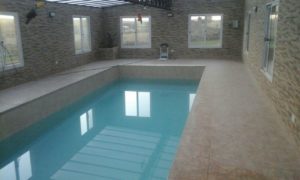
After the visit, which solution adopt to optimally configure the installation was going around in his head.
Appealing to the characteristic creativity of Argentine people, Federico took an unconventional solution: swimming pool conditioning by floor heating (in the transit zones of the enclosure and in the pool itself).
In this way it would achieve heat the pool regardless of the type of water containing the glass and more efficiently, since conventional pool heating has the negative inertia of moving water.
By heating the pool water with a conventional boiler the water is set into motion with the same pool pump, causing cooling it by this movement; which decreases the overall installation performance.
Therefore, a more powerful source of energy and more thermal reaction is needed.
We know that using solar energy do not have a large thermal reaction, ie the heating time is slower.
By heating the pool with underfloor heating water turns hot through the concrete, once in regime, it has more thermal inertia and allows solar energy to maintain that regime.
The radiant “glass” pool and the transit floor area of the enclosure receive input from a conventional gas boiler, which is responsible for putting installation in system, and 7 heat pipe collectors supplying directly fluid to the circuit (without heat exchanger) that transfers heat in sunshine.
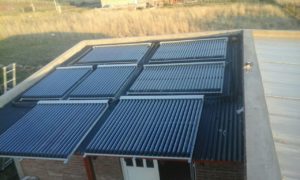
Temperature is regulated with a mixing thermostatic valve to not degrade the soil at high temperatures.
The system has a thermostat for transit zones and a thermostat for swimming pool water.
Then room or water temperature are discriminated with electric heads located at the underfloor heating collector, separating pool and transit zones of the enclosure.
The pool has a natural salt chlorination system (salt water 5%) thus avoiding the use of chlorine.
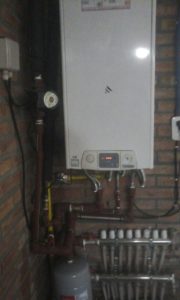
Having 2 separate circuits (the pool and underfloor heating), we protect the boiler to heat salt water, which quickly will cause severe and irreversible damage to it.
Federico Redin is Sopelia facilities expert advisor.
Costa Rica Solar Thermal
In mid-2015 was held in San Jose, Costa Rica an international event to bring together experts from different countries to share experiences on solar thermal technology developed in their areas.
The forum was jointly organized by the International Renewable Energy Agency (IRENA), the Latin American Energy Organization (OLADE), the Costa Rican Electricity Institute (ICE) and the National Metrology Institute of Germany (PTB).
The forum aimed to bring together experts to support the implementation of mechanisms for quality assurance in order to increase confidence in the technology and spur development, issues of products control, installations and installers, and a visit to the laboratory of solar energy and energy efficiency facilities of the Costa Rican Energy Institute was held.
The most important technical standards of the sector in Costa Rica are:
INTE * 03/01/28 / 2013. Solar thermal systems and components. Solar collectors. General requirements
INTE * 03/02/28 / 2013 Thermal solar systems and their components. Prefabricated systems. General requirements
INTE * ISO 9459-2 / 2013 Solar Energy. Systems for domestic water heating. External test methods for the characterization and yearly performance prediction of solar systems.

In Costa Rica, 41,3% of households use hot water systems (ACS), which mostly operate with electric power.
These systems represent an estimated national consumption of over 250 GWh / year.
It is very evident the need to establish a set of policies and incentives in order to achieve mass use of solar thermal technology in the residential sector.
These should include a technology implementation strategy, covering regulatory aspects, technical training and creation of laws governing the sector.
The aim would be to create a framework to introduce solar thermal systems to replace electric water heating equipment.
The country has approximately 1,200,000 homes for about 4,500,000 inhabitants (3,75 persons / household), of which only 3% are multifamily housing.
It follows that the basic ACS system for the average residential sector of Costa Rica with country radiation levels, would be payed at a more than reasonable time.
One of the most important facilities is located in a Tamarindo (Guanacaste) hotel.

A total of 164 collectors (330 m²) and 25,000 liters storage supplies hot water to 240 rooms and an industrial laundry, generating 529,600 kWh annually.
The investment will pay off in just 36 months with the savings generated.
Colombia Solar Thermal
The first record about solar thermal energy use in Colombia dates back to the 50s with the installation of solar heaters in the banana workers homes located in Santa Marta. The heaters still exist, but they do not work.
In the 60s Israeli solar heaters were installed in some universities in Santander and Bogota.
In the 80s in Medellin, Manizales, some neighborhoods of Bogota and later in the Atlantic coast, solar heaters began massively used; forcing regulation of their use through INCOTEC (Colombian Institute of Technical Standards).

In March 1993 the NTC 3507 was enacted, referring to domestic hot water systems powered by solar energy installations.
In mid 90s, with the support of foundations like Gaviotas, the use of solar heaters spread to hospitals and community centers.
Until 1996, 48.901 m2 of solar thermal systems had installed, mainly in neighborhoods of Medellin and Bogota with Central Bank funding.
All this development stopped short with the introduction of a cheaper energy source, natural gas, which displaced the market of this nascent industry from then until now.
Most systems work well but some users had other expectations of them, which has hinted that the demand exceeds the capacity of the equipments.

Currently, the solar industry remains depressed in Colombia waiting for a new energy crisis.
The only program that tried timidly incorporating solar thermal energy began in 2009 in San Andrés as part of the implementation of solar energy in buildings, to evaluate their behavior in a residential installation.
State action should be directed towards the solar thermal energy development:
– To diversify the national energy matrix and give flexibility to the power supply system
– To reduce the environmental impact of fossil fuels and the reserves depletion
– To provide power supply in remote and isolated áreas
The national energy policy should move towards a gradual increase of supply based on solar thermal energy, developing strategies and setting ambitious and achievable goals, consistent with a gases emissions reducing policy.
The Law URE (Rational Use of Energy) and 3683 Decree, have not been sufficient to promote this energy source, as evidenced results obtained from its promulgation.
Chile Solar Thermal
In Chile the energy business understood has caused solar thermal for domestic applications is not subsidized, while maintaining support for hydrocarbons.
It is easier to push price increases in residential electricity rates, which can not access direct contracts and are subject to pool generation system with intermediaries.
The 2014 budget left out solar subsidies for social housing infrastructure, despite the need to extend the Law 20,365 and that this be included in the raised budget.
As the law was not extended, 2 million Chileans were left without the possibility of having free hot water in their homes and solar thermal industry begins again fojas 0 after a boom.
Law 20,365 sought to create a natural market to make unnecessary the subsidy after 5 years, but as it only lasted two years, failed to meet that goal.
On Tuesday 12 January, 2016 the project to extend the law 20,365 and make a direct subsidy for solar thermal systems in social housing exceeded its final step in Congress. Only the law publication in Official Journal is needed to take effect.
For solar thermal industry has been too long waiting time of this law.
The effects of this extension will be diluted again if long term policies in favor of maintaining incentives for solar thermal energy by individuals and businesses are not adopted.

Not only is important solar thermal energy development in the residential sector. Copper mining, dairy products, wines, concrete, bakeries, sawmills and paper mills also present opportunities for incorporating solar thermal energy.
Most industries with potential to incorporate solar thermal energy identified are in the RM (middle región), with industrial plants concentration.
Implementation opportunities in the region VIII are scarce because solar thermal energy is currently not competitive with the use of biomass fuel, abundant in this region.

There are compelling reasons to encourage the development of solar thermal systems:
* It is key for real estate who want to get the “Energy Housing Seal”
* It is estimated that each housing with thermal solar equipment will stop producing 16 tons of CO2 over its lifetime
* Capacity building and business and technological development of the sector
* Each peso that the state invests has a high social returns
Solar Thermal Brazil
According to the IEA, Brazil is 4th in solar thermal installed capacity in the world ranking, but 32nd in solar thermal energy per capita among 57 countries.
Irradiation is extremely high in Brazil. The lowest level is in Santa Catarina, still 30% higher than the average in Germany.
Between 2009 and 2013, the Brazilian production of solar collectors grew at an annual average of over 15%, reaching an installed capacity of 9,6 million m2.
In 2012 Brazil accounted 1/3 global market of flat and pool heating collectors produced, with 965 MW, followed by Germany and the US.
Was the 5th country in solar collectors installed in 2013.
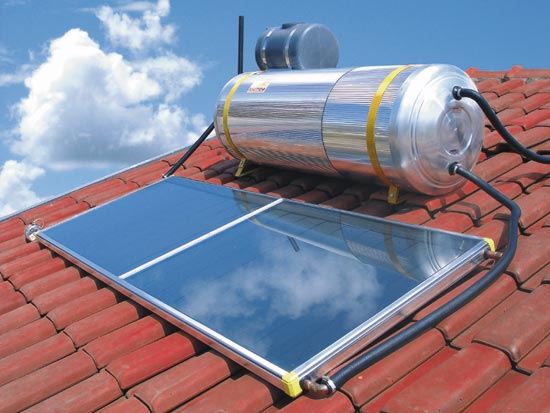
One aspect to improve are laws and regulations.
Many municipal laws are being implemented since 2006 and a few are already a reality in some cities like São Paulo.
Proposals to offer incentives for clean technologies and discounts on electricity fee to facilities equipped with solar water heating are also implemented.
In 2014, the Brazilian solar thermal park production reached 7,354 GWh from a total area of 11,24 million m2 of solar collectors installed in the country.
This year, collectors for solar water heating production grew by 4,5%, with the installation of 1,44 million m2 of collectors.
Considering a residential consumption average of 166 kWh / month, this amount of energy is enough to power 3,7 million households over one year. The city of São Paulo has 3,9 million homes.
Higher sales of solar thermal systems in 2014 were recorded in the Southeast with 61,94%, followed by the South with 21,81%, the Center-West with 10,44%. Regions with less market share were Northeast and North, with 4,51% and 1,69%, respectively.
51% of sales in 2014 was allocated to the residential segment, compared to 9% in 2013.
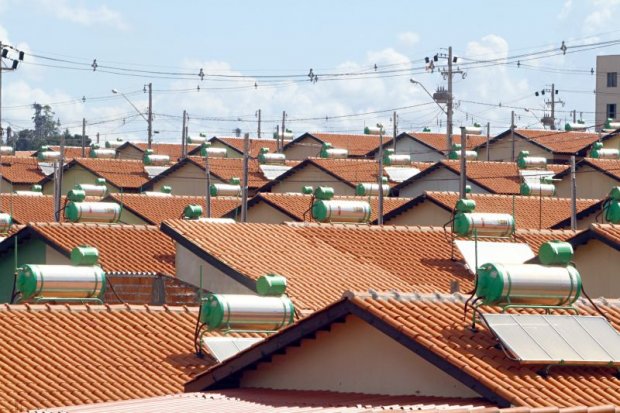
But the big news was use of solar energy in industry expanding. 17% in 2014 compared to 3% in 2013.
By contrast, housing programs sales was reduced from 19% to 16% in 2014.
Commercial and services segments also recorded a 16% in 2014.
The Basic Sanitation Company of São Paulo State (Sabesp) has installed a Treatment Plant Wastewater solar heater in Taubaté and Trebembé cities. The system heat water to 55 ° C for two centrifuges and other washing elements.
Low-income families in towns of Lorraine and Cachoeira Paulista, in São Paulo state, will benefit from the project “Good Solar Energy”, which envisages the installation of solar thermal energy in more than 383 homes, plus kits with fluorescent lamps.
Solar Thermal Bolivia
In Bolivia, it is estimated that solar thermal installations will increase at a pace of around 500 per year across the country.
This growth is obviously too slow considering Bolivia’s solar potential.
Its radiation is so high that many applications of solar thermal energy could be used.
However, the domestic market is emerging and there are few companies dedicated to this technology.
The most active area is located in the central region of Cochabamba where there are 5 companies that are mainly engaged in thermosiphon equipment installations.

In Bolivia, energy is only available to a small proportion of the population. Broad sectors of poor people in rural areas are not connected to the public electricity network.
The electricity and gas distribution network do not reach these remote regions because this expansion would not result in profits for suppliers.
The use of solar thermal energy has an enormous potential for providing hot water to communities in the highlands, where there are very low temperatures that adversely affect the region’s production and people’s daily activities.
Weather conditions in the Bolivian highlands are extreme due to night frosts. Water from pits or pipes have a very low temperature and therefore it needs to be heated by electricity or gas for people’s personal hygiene and for washing clothes and various items.
As Bolivia is located near the Equator, solar radiation is very high and with no variation between summer and winter periods. Therefore, there are ideal conditions for using solar energy in water heating.
From all of the above, it is clear that the key to overcoming this situation is to stimulate the solar thermal products market growth through policies that affect both supply and demand in the departments of La Paz, Oruro and Cochabamba.

This would contribute to poverty alleviation, environmental conservation and natural resources protection.
From a business point of view, this would encourage the establishment of many companies in the area.
The spread of this technology is currently limited in Bolivia by:
– Technological shortcomings
– Lack of means for certification rating
– Inefficient structures in service, sales and maintenance
– Distrust of potential users
– High production and services costs originated in limited production and sales volumes
– Poor access to financing
– Lack of state incentives (financing, subsidies or tax exemptions).
